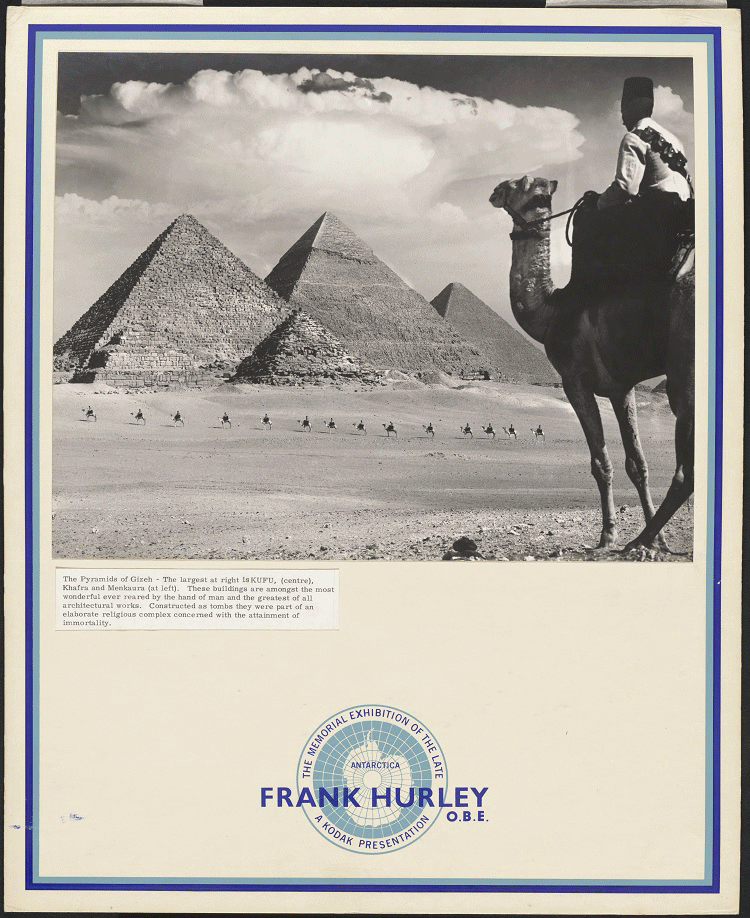‘Hurley believed that nature should never be seen as she was – as through a glass, darkly – but as she should be.’[1]
Reading about Frank Hurley, one of the most famous photographers of the twentieth century, is always a bit of a thrill. His life was like something out of a H. Rider Haggard novel – full of expeditions to far off places, swashbuckling adventures, and the might of the British Empire. This was the man who journeyed to Antarctica six times, including aboard Shackleton’s doomed Endurance, travelled all over the globe, flew with heroes of early aviation, witnessed two world wars and photographed kings, queens and presidents.
Untangling the myth of Frank Hurley’s life involves reading between the lines – those written by people rather breathlessly recounting his adventures, or those that he wrote himself. Hurley was remarkably adept at cultivating this heroic image of himself to open doors and make money. A consummate storyteller, Hurley loved to tell yarns to a captive audience; around a campfire, in a wartime dugout or huddled under a makeshift shelter in the Antarctic. As Alastair McGregor pointed out in his excellent analysis[2], Hurley often exaggerated or even lied to put himself front and centre at several events, and his diaries show signs of careful editing after the fact.
The idiom that one shouldn’t let the truth get in the way of a good story also deeply affected his practice as a photographer. Influenced by the Pictorialism movement, Hurley believed that photography was an art form, not a science. He would artistically manipulate images and create composites during production, instead of treating them as a documentary recording of life. Some of Hurley’s most famous photographs are examples of this, including ‘A Blizzard,’ ‘Going over the Top,’ and ‘Dawn at El Alamein’. This practice would get him in trouble with his superiors throughout his life. I’d be willing to bet that Hurley, if still alive, would be an enthusiastic user of Instagram filters and Photoshop.

In the same way, behind the myths of his own creation was a man who seemed a relic of a bygone era, one who didn’t quite fit into with his suburban Sydney surroundings. He avoided most company, especially that of women. When he was (infrequently) at home with his family, he spent most of his time working in his dark room or in the garden. His own daughter said:
‘He never, never should have married! He never should have had the responsibility of children! He was a get-up-and-go man, and explorer, an adventurer. He could not bear being restricted and it was clear that he could never be a normal husband or father. He was – different.’[3]
He was also a bit of an imperialist, and aligned himself with a long tradition of ideas about adventure narratives, ‘natives’ and masculine exploration. His photographs show a sort of colonising vision; he would photograph people as exotic ethnographic ‘types’ such as the ‘Nobel Savage,’ ‘Gentle Farmer,’ or ‘Silent Arab,’ rather than individual human beings. He also, whilst in Papua New Guinea, recounts[4] collecting cultural artefacts through irregular methods. These shades in his character are a little harder to swallow; I think we sometimes prefer historic people to be purely heroic.
Whether or not such Hurley’s exaggerations are acceptable when storytelling or taking photographs, I will leave up to you. Pilgrimage: Hurley in the Middle East is open until 1 December.
[1] David P. Millar, Snowdrift to Shellfire: Capt. James Francis (Frank) Hurley 1885-1962, (Sydney, David Ell Press, 1984) p. 141
[2] Alastair McGregor, Frank Hurley : a photographer's life, (Canberra, National Library of Australia, 2019)
[3] Lennard Bickel, In Search of Frank Hurley, (South Melbourne, Macmillan, 1980), p. 127
[4] Robert Dixon and Christopher Lee (ed), The diaries of Frank Hurley 1912-1941, (New York, Anthem Press, 2011) p. 212